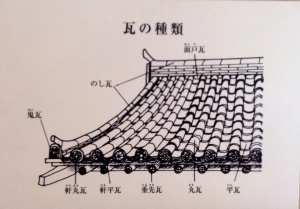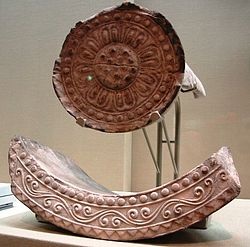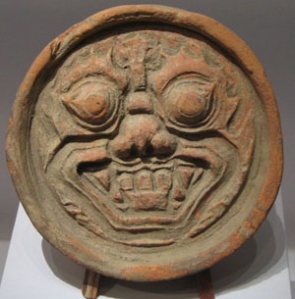
Onigawara goblin gargoyle or roof tile ornament
Onigawara (鬼瓦 ) are a type of Japanese ogre- or goblin- gargoyle and roof tile ornamentation found in Japanese architecture. Literally translated as ‘ogre tile’, the roof tile ornaments traditionally depict a Japanese ogre (oni) or a fearsome beast, but also commonly include many other motifs such as floral (alternatively known as hanagawara 花瓦) and animal designs. Swirling or wave patterns found at the bottom right and left of the onigawara are called hire 鰭.

A magnificent example of onigawara at the 1,400 year old Ono-Jodoji temple. Prince Shotoku, is said to be the founder of Onomichi’s Jodoji Temple which is also famous for its connection with the Shogun Takauji Ashikaga, who is said to have worshipped here. Photo: Wikimedia Commons
Onigawara are usually ceramic but may occasionally be made of stone or wood.
The oni goblin design motif is thought to have originated from a previous architectural element, the oni-ita, 鬼板 which is a board painted with the face of an oni and was meant to stop roof leaks.
The earliest onigawara tiles are dated to the Nara Period.

Nara Period onigawara from Todaiji (Kondo structure) Temple. Photo: Fidel Ramos
Onigawara are also be found decorating temples and palaces, not just shrines. The largest onigawara (World Guiness Records) made of clay, measures 9 m (29 ft 6 in) tall and 8.8 m (28 ft 10 in) wide, is found on the rooftop of the main building of Nenbutsushu Muryojuji Temple , Mikawa Bay.

A tile roofing explanation of the different types of tiles, and the placement of the onigawara tile at the furthest edge in order to ward off evil – at the Tama Center Archaeological Center
The onigawara roof tile technique may have been introduced by Korean ceramic potters as similar onigawara tiles have been excavated in Korea, but the earliest roof tiles were from the Han Dynasty China.
To understand the origin and evolution of the Oni cultural figure in Japan, see Oni and their Maces: Images of Oni from Onmyodo and Medieval Traditions.
***
Visit Kawara Museum of the City of Takahama, in Aichi prefecture — the only art museum in the world that specializes in the theme of roof tiles, and just outside the museum, the one-and-a-half-mile goblin trail or “Oni-no-michi” which is dotted with various examples of scowling onigawara. “Kawara” is translated as “roof tile.”
Examine the unmatched kawara tile display in Kawara Museum. Located in Takahama City, which, together with neighbouring Hekinan, has been a major centre of roof-tile (kawara) production for centuries and remains the main producer of Sanshu-kawara with Japan’s top domestic output of kawara.
At the Kawara museum you can obtain an up-close look at the best of the region’s roof tiles, feel the beauty and appeal of kawara through the outstanding collection and exhibits of pottery products including kawara from different periods and pottery-producing regions across Japan, as well as kawara/pottery from around the world.
In addition, artwork (paintings, block prints, ukiyoe – Japanese woodblock prints, calligraphy, photography, etc.) and literature related to kawara/pottery can also be viewed at the museum. Art students can find inspiration in the landscape designs and roof tile paintings as artistic motifs.
Visitors can also experience the joy of hands-on pottery-making by kneading clay at the half-day workshop.

かわら美術館 Kawara Bijutsukan9-6-18 Aoki-cho, Takahama city 444-1325 Tel: 0566-52-3366
Access: 8 minutes on foot from Takahama-minato station on Meitetsu Mikawa line. From Meitetsu Nagoya Station to Takahamako Station on the Meitetsu Mikawa Line – Hekinan direction through Chiryu Station (approx. 50 mins, 710 yen), an approx. 10-minute walk from Takahamako Station
To view a stunning collection of onigawara, go to the online Flicker gallery of onigawara photos, and click here.
SOURCE REFERENCES & FURTHER READINGS:
Onigawara (the JAANUS archive)
Onigawara (Onmark productions)


Thank you very much for the information! I am writing about the Oni-gawara for a paper for an Arts of Japan class at the University of Pennsylvania. I was confronted with limited sources and found this site to be very helpful in understanding the genre and origins of Oni-gawara as an architectural element.
[…] first is an Asuka period onigawara (This is also interesting.) from Okuyama Kumedera, 奥山 久米寺 The temple is often confused with Kumedera, […]